
 BEEP PC SPEAKER in 1981 PC compatibile systems were unappealing featuring poor graphic CGA coulour and lacking any decent sound devices. In the meantime the incredible Commodore 64 SID Chip system was able to generate 3-channels music with lightweight code, not to mention the later Commodore Amiga PAULA chip (1985) with 4 PCM stereo voices.
BEEP PC SPEAKER in 1981 PC compatibile systems were unappealing featuring poor graphic CGA coulour and lacking any decent sound devices. In the meantime the incredible Commodore 64 SID Chip system was able to generate 3-channels music with lightweight code, not to mention the later Commodore Amiga PAULA chip (1985) with 4 PCM stereo voices.

This first PC sound wailing was a primitive buzzer sysem is played through a mono speakers BEEPER mainly used to signal some specific boot issues. Basically the pc "beeper" generates 1 voice with a raw square wave ad variable frequencies (notes) but later with a lot of tricks some programs were able to have more polyphony and even to replay low-resolution samples like 1-bits PWM raw up to even 6/8 bits resolution.
 LISTEN TO: Monkey island theme with Beeper LISTEN TO: Monkey island theme with Beeper
|
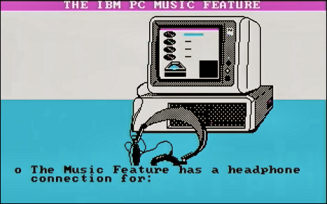 |

 AdLib Music Synthesizer Card in 1987 Canadian society lead by Martin Prevel released the Adlib 8-bits ISA soundcard based on FM synthesis - frequency modulation - developed from 1973 by John Chowning then commercialized by Yamaha Corporation in many synthesizers including the most known and best-seller model Yamaha DX7.
AdLib Music Synthesizer Card in 1987 Canadian society lead by Martin Prevel released the Adlib 8-bits ISA soundcard based on FM synthesis - frequency modulation - developed from 1973 by John Chowning then commercialized by Yamaha Corporation in many synthesizers including the most known and best-seller model Yamaha DX7.
OP ADLIB sound is mainly generated by a chip IC YM3812 also known as a OPL2 (Operator Type L2) featuring 9 voices polyphony, 2 Operators per channel, 2 algorithms and 4 waveforms (classic sinewave + 3 harmonic variations) - relative DAC is a YM3014.
The previous chip from OPL series is the OPL1 / YM3526 IC implemented on some MSX home computer: I do not t have much information about this one, but it seems to be quite similar to OPL2 with 9 channels and a 2-agorithm structure, probably lacking sinewave variations.

GAME SUCCESS:
in 1988 the famous adventure games society Sierra released the first ADLIB soundtrack (King's Quest IV hear a clip below) which boosted sales around the world. Year later, a yet-not-so famous society CREATIVE LABS launched the Soundblaster with same OPL chip + PCM sample engine - a fatal hit for the Canadian society which closed in 1992.
 LISTEN TO: King's Quest IV: perils of Rosella with ADLIB LISTEN TO: King's Quest IV: perils of Rosella with ADLIB
|
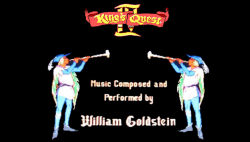 |

 ROLAND MT-32 not really a sound card but a module expander released by famous synth society Roland in 1987 compliant to MIDI system (but not to MIDI-GS/GM/XG protocol) that can be hooked to a PC with any old or modern Midi interface. PC-card equivalent is the ISA Roland LAPC-1 but definitely less famous.
ROLAND MT-32 not really a sound card but a module expander released by famous synth society Roland in 1987 compliant to MIDI system (but not to MIDI-GS/GM/XG protocol) that can be hooked to a PC with any old or modern Midi interface. PC-card equivalent is the ISA Roland LAPC-1 but definitely less famous.
MT32 sound generation is based on short samples transients + some PCM waves stored on the internal ROM. IN this way, the PC was CPU load-free and sound was quite realistic for soundtrack the time and drums began to sound like (quite) a true one.
As a pure synth fan, the MT-32 is now old and not so interesting: 32 voices based on a low-cost version of L.A synthesis whose flagship and true synth is the model D-50. Check out -
polynominal dedicated ROLAND MT32 PAGE.

MT32 GAMING the module is not really appreciated amongst musicans, but it is a piece of gaming history for retro-game players. About 1992, the MT32 protocol were replaced by wavetable Soundcanvas module/boards for a short period then gradually replaced by full sampled music about 1998.
 LISTEN TO: Dune (Exxos) by Mt32 LISTEN TO: Dune (Exxos) by Mt32
|
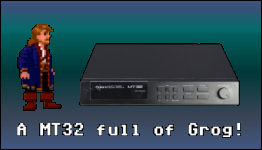 |

 SOUNDBLASTER in 1988 Creative Labs made some deal with Yamaha to have the OPL2 license, thus the CMS card (Creative Music System) a kind of Soundblaster prototype was born.
SOUNDBLASTER in 1988 Creative Labs made some deal with Yamaha to have the OPL2 license, thus the CMS card (Creative Music System) a kind of Soundblaster prototype was born.
The CMS keeps same FM music system and OPL chip adding a mono PCM digital sample player (rate for Playback/Recording Mono: 5 kHz / 22.1 kHz) at 8 bits resolution based on Phillips SAA-1099 IC.
-1991 SB PRO the Soundblaster "PRO" version upgraded sampling to up to 22.05 kHz stereo / 44.1 kHz mono, then PRO2 replaced the OPL2 YM with a new backward-compatible OPL3 chip YMF262 which doubles polyphony, 4 more sinewave variations and more.

-1992 CD QUALITY the new 16 bits plug-and-play SOUNDBLASTER 16 was introduced with sought-after 16 bits 44 kHz cd quality, also a dual OPL2 and a waveblaster connector able to play WAVETABLE Midi tracks.
The following model Awe32 introduced internal RAM to play own sampled sounds: the ADLIB FM synthesis (and MT32) began to decline replaced by far more realistic WAVETABLE sampled synthesis, furthermore last AWE32 generation did feature some (not so good) EMU/ENSONIQ ADLIB-Chip emulation missing YM OPL chips.
-1998 PCI In 1998 the PCI format permanently killed OPL chips and even wavetable music began to gradually disappear to be replaced by full-sampled soundtracks and effects.
- from 2001 AUDIGY to TODAY RAM and system are now so powerful they can manage any sampled sources at 5.1 at full quality, but all of these are often produced in recording studio using VST and plugins system... but this is a another story.

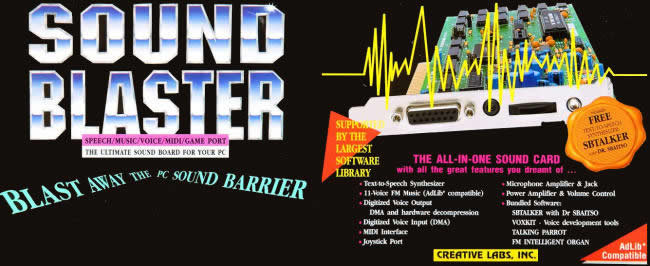
 NOTABLE COMPETITORS:
NOTABLE COMPETITORS:
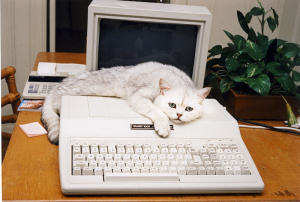
|
Tandy 1000 (1984) features 3-square tone + 1 noise channels based on SN76496IC VIDEO
|
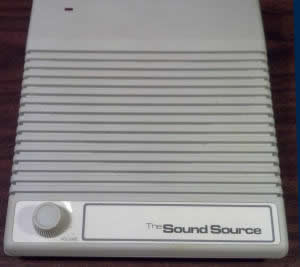 |
Disney Sound Source (1991-1992) 8 bits samples player, easy to configure in parallel port VIDEO |
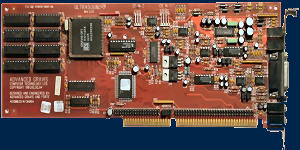 |
Gravis UltraSound (1992) cult board amongst aficionado, way ahead it's time. This 16 bits cards was able to use sampled sounds up to 1 mega (256 standard) VIDEO |
